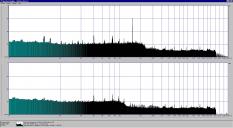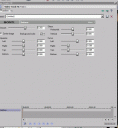
-
Sorry I was wrong it is 12/14/2012(Friday) instead.
-
Great!
-
Tomorrow.
-
I was surprised that the device itself can't playback. But the upcoming smartphone app will be able to playback. Any date for the app release?
-
I tested the audio inputs using my GoPro 3 microphone input cable (which arrived today). I had previously tried to make my own cable, and failed :-(
There is a DC level of 4V on each mic input, which will drive the average electret insert very well. I shorted the unused mic input and applied an ultra-low distortion sinewave generator to the other. The spectral graphs which resulted are shown below for 2mV, 20mV and 150mV RMS inputs respectively.
There is clearly Automatic Gain Control being applied to the input, with a compression level giving plenty of pumping headroom, at about -25dB0. The channel separation is about 40dB, but there is significant change in the second channel noise level, there should not be any. Harmonic distortion is low enough, but clearly there are audible effects in the noise level. I would like to check the IM distortion, but was too busy today. The AGC comes in just above 2mV RMS input level.
These are not HiFi inputs by any stretch of the imagination. I will plug my Rode's into a real audio recorder, and sync the files in post...

 2mVrms_short.jpg1920 x 1056 - 162K
2mVrms_short.jpg1920 x 1056 - 162K
 20mVrms_noshort.jpg1920 x 1056 - 184K
20mVrms_noshort.jpg1920 x 1056 - 184K
 150mVrms_short.jpg1920 x 1056 - 161K
150mVrms_short.jpg1920 x 1056 - 161K -
Thanks. I'm charging it.
-
I have used a variety of chargers, including the 1 inch cube iPhone charger, on my GoPro. I see no reason why it would be sensitive to charger, and I have seen no problems either.
-
I can't believe they actually delivered GP3 black to my door!!!
One question. Is it safe to use iPhone USB charger on GP3?
-
Looks like the GP3 can be matched reasonably well to a 5D MKII when using the right settings
-
@obnoxious2 I don't know whether it is relevant in your situation with premiere pro, but my sony vegas uses cineform as a native format, and will show HD previews in real time in this format (despite the high bit rate). I do recall seeing an option under the "C" which pops up in the status bar while Cineform is running which claims to speed full-screen playback. I don't have any problems with speed, but I thought you might be interested in knowing the switch is there :)
The only downside to Cineform is the high data rate and consequent huge files. But it loses nothing from generation to generation, previews in real time, and IMO is the ideal editing format.
-
I don't know much technical detail on the dynamic range but I went back and used cineform to process before I edited in premiere pro and I will say this:
1) Didn't notice much difference in color saturation 2) There is a big big difference in the sharpness and contrast.
-
Here is a shot of the RGB parade from my Vegas from a typical 1080p_24T cineform-converted clip. Note the discrete quantization levels. I haven't counted them, but there are a few gaps, and I suspect there are fewer than 256 here... But there are enough to give smooth color...

 Protune_Parade.jpg440 x 686 - 74K
Protune_Parade.jpg440 x 686 - 74K -
Essentially a larger dynamic range is "compressed" into the h.264 file. When you process it in Cineform Studio it applies the Protune curve, which decompresses or expands the dynamic range closer to the original of the scene. For technical details, David Newman explains it fully here, math included: http://cineform.blogspot.ca/ See the second post, Wednesday, October 10, 2012 Protune. Hopefully it will make more sense!
-
@Zakk @ mpgxsvcd As I understand it, the gamma is turned into a log curve in the camera, so that a wider range of video levels can be truncated down to fit in the 3x8 bit MP4 container. GoPro Cineform Studio then expands these to the 10 bit range, although there will obviously only be 256 discrete levels across that 10 bit range. That is not so unusual, when watching the RGB parade levels on my Sony Vegas I frequently see quantization steps in the videos from cameras, especially near black. Actually, I was just looking at a Protune clip, and it seemed pretty continuous to me, with levels smooth from 0 to 255. When I run Cineform Studio in the background while I am editing the clip in Vegas, changes made to the white balance, etc, in CS appear immediately on my Sony Vegas timeline. Pretty interesting... But I am concerned what happens when I archive the masters away for a time when CS no longer exists...
Oh -when I render from the Vegas timeline, it seems I can use Cineform as the output codec, as long as Cineform Studio is installed and I don't output resolutions above 1920x1080. I have complained to Cineform Tech Support that they need to allow me to support 2K7, even if they reserve 4K for the bigger-pocketed pros...
-
+1 inquiring minds want to know.
-
@trevmar: I don't get it. All GoPros record using the h.264 codec which is 8-bit 4:2:0.
So how does a 10 bit 4:2:2 workflow give you more dynamic range if the source is only 8-bit?
-
@trevmar "After running through GoPro Cineform Studio the metadata is retained in the 10-bit dynamic range 4:2:2 clip. That allows you to change white balance, brightness, saturation, etc, in a non-destructive manner. Which is what Cineform Studio does, before it exports to MP4 again. Cineform is a wonderful workflow, and has saved me a lot of grief over the years.
When you play with the MP4 files the dynamic range available is only 8 bits. This makes it tough to maintain gradation in the shadows and highlights."
Thanks for the info! I don't really understand the 4:2:2 stuff but basically I should just convert with cineform (without any color correction changes) and then color correct in premiere or whichever NLE I want? I originally tried the cineform color correction and sharpness/contrast and the video came out way too red in some areas while others were perfect (was going for cinema feel). I like how in premiere it breaks down color correction by shadows, midtones, and highlights.
edit I'm not home currently but if I remembered correctly cineform can let you export in avi and mp4. Which should I want or is that irrelevant as long as it has converted it.
edit2 Looks like I found some more info here and basically reinforces what trevmar has been saying. http://gopro.com/wp-content/uploads/2012/02/GoPro-CineForm-Studio-Manual-01.pdf
The interesting tidbit I found is any edits I make on cineform immediately shows up in NLE without having to reimport the source file.
-
Oh gawd. I'm still waiting for GPB deal ($303) delivered to my door. Hopefully I get it this year before the snow!!!
-
Is this conversion needed for Gopro 1 etc as well or for Protune only? btw Cinema Studio=Cineform?
-
@obnoxious2 @BlueBomberTurbo After running through GoPro Cineform Studio the metadata is retained in the 10-bit dynamic range 4:2:2 clip. That allows you to change white balance, brightness, saturation, etc, in a non-destructive manner. Which is what Cineform Studio does, before it exports to MP4 again. Cineform is a wonderful workflow, and has saved me a lot of grief over the years.
When you play with the MP4 files the dynamic range available is only 8 bits. This makes it tough to maintain gradation in the shadows and highlights.
-
Premiere and After Effects will significantly clip the shadows and highlights. Run the MP4 through 5DtoRGB first using 601 to preserve them.
-
@trevmar " I am guessing you are using the Protune clip from the camera, and not reconstructing the saturation and grading by 'developing' the 'camera-raw' video footage in Cinema Studio. When CS converts the footage to normal AVI-cineform, it takes the metadata stored in the Protune camera-raw clip, and uses it to restore the original densities in the 10-bit 4:2:2 AVI-cineform container. This is necessary because Protune uses a logarithmic density profile, not a gamma-based profile."
Do you have to use cineform to convert to avi before using premiere pro to color correct? Will I lose density profile by just pulling the raw mp4 source into premiere pro and editing and exporting it from there?
-
Thanks for the settings, I'll try it out! I remember playing with that filter before but didn't come up with anything decent, so figured I was barking upt he wrong tree. I should've just stuck with it a little longer. Now I just need these things to get released in Canada... it's coming SOON!
-
I use the inbuilt Sony Deform filter with values as attached. Start with these values, you might want to later add back a little fisheye in some of your scenes. Whenever you change a variable, also change the negative variable with the same value:

 Vegas_Deform_Filter_Values_crop.gif663 x 719 - 17K
Vegas_Deform_Filter_Values_crop.gif663 x 719 - 17K -
@trevmar how are you removing the fisheye with Vegas? A plugin, or am I missing something in the built-in filters? And thanks for the extra info about the other modes feeling 'unfinished'. Good to know. Hopefully someday they will be 'finished' then!
Howdy, Stranger!
It looks like you're new here. If you want to get involved, click one of these buttons!
Categories
- Topics List23,992
- Blog5,725
- General and News1,354
- Hacks and Patches1,153
- ↳ Top Settings33
- ↳ Beginners256
- ↳ Archives402
- ↳ Hacks News and Development56
- Cameras2,367
- ↳ Panasonic995
- ↳ Canon118
- ↳ Sony156
- ↳ Nikon96
- ↳ Pentax and Samsung70
- ↳ Olympus and Fujifilm101
- ↳ Compacts and Camcorders300
- ↳ Smartphones for video97
- ↳ Pro Video Cameras191
- ↳ BlackMagic and other raw cameras116
- Skill1,960
- ↳ Business and distribution66
- ↳ Preparation, scripts and legal38
- ↳ Art149
- ↳ Import, Convert, Exporting291
- ↳ Editors191
- ↳ Effects and stunts115
- ↳ Color grading197
- ↳ Sound and Music280
- ↳ Lighting96
- ↳ Software and storage tips266
- Gear5,420
- ↳ Filters, Adapters, Matte boxes344
- ↳ Lenses1,582
- ↳ Follow focus and gears93
- ↳ Sound499
- ↳ Lighting gear314
- ↳ Camera movement230
- ↳ Gimbals and copters302
- ↳ Rigs and related stuff273
- ↳ Power solutions83
- ↳ Monitors and viewfinders340
- ↳ Tripods and fluid heads139
- ↳ Storage286
- ↳ Computers and studio gear560
- ↳ VR and 3D248
- Showcase1,859
- Marketplace2,834
- Offtopic1,320




